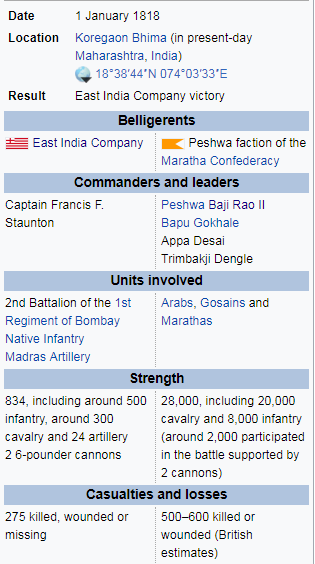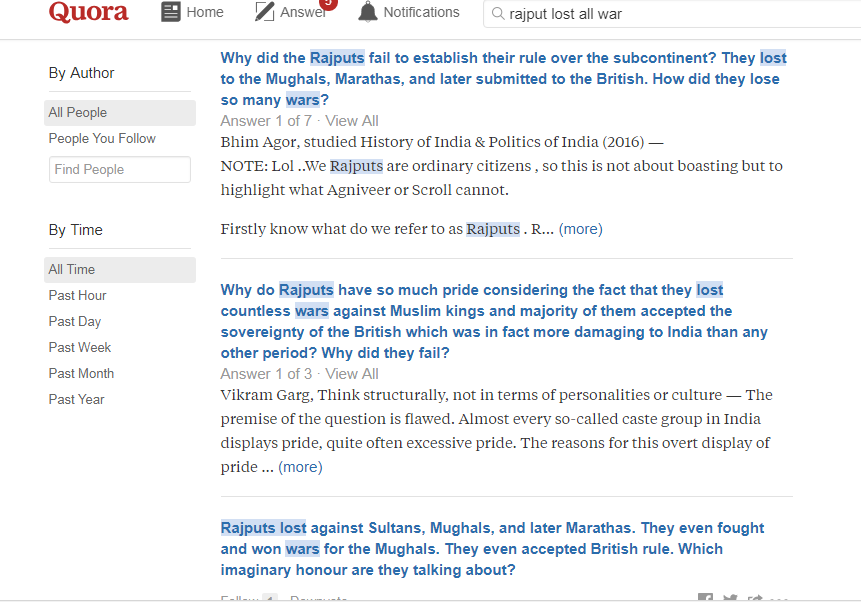For those who don’t believe or do not know of the amount of destruction that took place in India at the hands of the Muslim invaders and Islamic rulers who established themselves in parts of India, we can review the Islamic chronicles of the deeds of these rulers of the day, as written by the Muslim contemporary writers or historians. So what follows is a review of some of the books and their authors who recorded the histories of the Islamic rulers, and quotes from some of the descriptions within them about the cities they attacked and the temples they destroyed. It really shows how demoniac and cruel these rulers were.
The evidence of destruction of thousands of Hindu temples can be primarily found from two different sources:
1. Literary Evidence from the work of renowned Islamic historians
2. Epigraphic Evidence from the inscriptions on numerous Mosques all over India.
This article deals with only the literary evidence.
Hundreds of Muslim historians have glorified the deeds of their Muslim heroes all over India. This by no means is an exhaustive list! To learn more about this, please read both volumes of, Hindu Temples: What Happened To Them? by Sita Ram Goel.
There is elaborate literary evidence from the Islamic sources which glorify the crimes committed by the Muslims in India. Crimes such as the desecration of the Hindu idols, looting of the temples, killing devotees and raping have been well documented by the Muslim historians themselves. They have done so because according to them these Muslim rulers by doing such deeds were following the tenets of Islam and Sunnah of the prophet Mohammed. The literary evidence stated below is in chronological order with reference to the time at which a particular work was written.
1. Name Of The Book: Hindustan Islami Ahad Mein (India under Islamic Rule)
Name Of The Historian: Maulana Abdul Hai.
About The Author: He is a highly respected scholar and taken as an authority on Islamic history. Because of his scholarship and his services to Islam, Maulana Abdul Hai was appointed as the Rector of the Darul Nadwa Ullum Nadwatal-Ulama. He continued in that post till his death in February 1923.
The following section is taken from the chapter Hindustan ki Masjidein (The mosques of India) of the above mentioned book. Here we can see a brief description of few important mosques in India and how each one of them was built upon plundered Hindu temples.
a. Qawwat al-Islam Mosque at Delhi: "According to my findings the first mosque of Delhi is Qubbat al-Islam or Quwwat al-Islam which, Qutubud-Din Aibak constructed in H. 587 after demolishing the Hindu temple built by Prithvi Raj and leaving certain parts of the temple outside the mosque proper; and when he returned from Ghazni in H. 592 he started building, under orders from Shihabud-Din Ghori, a huge mosque of inimitable red stones, and certain parts of the temple were included in the mosque..."
b. The Mosque at Jaunpur: "This was built by Sultan Ibrahim Sharqi with chiseled stones. Originally it was a Hindu temple after demolishing which he constructed the mosque. It is known as the Atala Masjid."
c. The Mosque at Qanauj: "It is well known that this mosque was built on the foundations of some Hindu temple that stood here. The mosque was built by Ibrahim Sharqi in H. 809 as is recorded in Gharbat Nigar."
d. Jami Masjid at Etwah: "This mosque stands on the bank of the Jamuna at Etawah. There was a Hindu temple at this place, on the site of which this mosque was constructed. ."
e. Babri Masjid at Ayodhya: "This mosque was constructed by Babar at Ayodhya which Hindus call the birth place of Ramchandraji... Sita had a temple here in which she lived and cooked for her husband. On that very site Babar constructed this mosque in H.963 "
f. Mosque at Benaras: "Mosque of Benares was built by Alamgir Aurangzeb on the site of Bisheshwar Temple. That temple was very tall and held as holy among Hindus. On this very site and with those very stones he constructed a lofty mosque, and its ancient stones were rearranged after being embedded in the walls of the mosque. It is one of the renowned mosques of Hindustan."
g. Mosque at Mathura: "Alamgir Aurangzeb built a mosque at Mathura. This mosque was built on site of the Govind Dev Temple which was very strong and beautiful as well as exquisite."
2. Name Of The Book: Futuhu'l-Buldan
Name Of The Historian: Ahmed bin Yahya bin Jabir
About The Author: This author is also known as al-Biladhuri. He lived at the court of Khalifa Al-Mutawakkal (AD 847-861) and died in AD 893. His history is one of the major Arab chronicles.
The Muslim Rulers He Wrote About:
a. Ibn Samurah (AD 653)
Siestan (Iran)
"On reaching Dawar, he surrounded the enemy in the mountain of Zur, where there was a famous Hindu temple." "...Their idol of Zur was of gold, and its eyes were two rubies. The zealous Musalmans cut off its hands and plucked out its eyes, and then remarked to the Marzaban how powerless was his idol..."
b. Qutaibah bin Muslim al-Bahili (AD 705-715)
Samarkand (Farghana)
"Other authorities say that Kutaibah granted peace for 700,000 dirhams and entertainment for the Moslems for three days. The terms of surrender included also the houses of the idols and the fire temples. The idols were thrown out, plundered of their ornaments and burned..."
c. Mohammed bin Qasim (AD 712-715)
Debal (Sindh)
"...The town was thus taken by assault, and the carnage endured for three days. The governor of the town, appointed by Dahir, fled and the priests of the temple were massacred. Muhammad marked a place for the Musalmans to dwell in, built a mosque, and left 4,000 Musalmans to garrison the place..."
"...Ambissa son of Ishak Az Zabbi, the governor of Sindh, in the Khilafat of Mu'tasim billah knocked down the upper part of the minaret of the temple and converted it into a prison..."
Multan (Punjab)
"...He then crossed the Biyas, and went towards Multan...Muhammad destroyed the water-course; upon which the inhabitants, oppressed with thirst, surrendered at discretion. He massacred the men capable of bearing arms, but the children were taken captive, as well as ministers of the temple, to the number of 6,000. The Musalmans found there much gold in a chamber ten cubits long by eight broad..."
d. Hasham bin 'Amru al-Taghlabi
Khandahar (Maharashtra)
"He then went to Khandahar in boats and conquered it. He destroyed the Budd (idol) there, and built in its place a mosque."
3. Name Of The Book: Tarikh-i-Tabari
Name Of The Historian: Abu Ja'far Muhammad bin Jarir at-Tabari
About The Author: This author is considered to be the foremost historian of Islam. The above mentioned book written by him is regarded as the mother of histories.
The Muslim Rulers He Wrote About:
a. Qutaibah bin Muslim al-Bahili (AD 705-715)
Beykund (Khurasan)
"The ultimate capture of Beykund (in AD 706) rewarded him with an incalculable booty; even more than had hitherto fallen into the hands of the Mohammedans by the conquest of the entire province of Khorassaun; and the unfortunate merchants of the town, having been absent on a trading excursion while their country was assailed by the enemy, and finding their habitations desolate on their return contributed further to enrich the invaders, by the ransom which they paid for the recovery of their wives and children. The ornaments alone, of which these women had been plundered, being melted down, produce, in gold, 150,000 meskals; of a dram and a half each. Among the articles of the booty, is also described an image of gold, of 50,000 meskals, of which the eyes were two pearls, the exquisite beauty and magnitude of which excited the surprise and admiration of Kateibah. They were transmitted by him, with a fifth of the spoil to Hejauje, together with a request that he might be permitted to distribute, to the troops, the arms which had been found in the palace in great profusion."
Samarkand (Farghana)
"A breach was, however, at last effected in the walls of the city in AD 712 by the warlike machines of Kateibah; and some of the most daring of its defenders having fallen by the skill of his archers, the besieged demanded a cessation of arms to the following day, when they promised to capitulate. The request was acceded to the Kateibah; and a treaty was the next day accordingly concluded between him and the prince of Samarkand, by which the latter engaged for the annual payment of ten million of dhirems, and a supply of three thousand slaves; of whom it was particularly stipulated, that none should either be in a state of infancy, or ineffective from old age and debility. He further contracted that the ministers of his religion should be expelled from their temples and their idols destroyed and burnt; that Kateibah should be allowed to establish a mosque in the place of the principal temple...."
"...Kateibah accordingly set set fire to the whole collection with his own hands; it was soon consumed to ashes, and 50,000 meskals of gold and silver, collected from the nails which had been used in the workmanship of the images."
b.. Yaqub bin Laith (AD 870-871)
Balkh and Kabul (Afghanistan)
"He took Bamian, which he probably reached by way of Herat, and then marched on Balkh where he ruined (the temple) Naushad. On his way back from Balkh he attacked Kabul..."
"Starting from Panjhir, the place he is known to have visited, he must have passed through the capital city of the Hindu Sahis to rob the sacred temple -- the reputed place of coronation of the Sahi rulers -- of its sculptural wealth..."
"The exact details of the spoil collected from Kabul valley are lacking. The Tarikh [-i-Sistan] records 50 idols of gold and silver and Mas'udi mentions elephants. The wonder excited in Baghdad by baghdad by elephants and pagan idols forwarded to the Caliph by Ya'qub also speaks for their high value."
4. Name Of The Book: Tarikhu'l-Hind
Name Of The Historian: Abu Rihan Muhammad bin Ahmad al-Biruni al-Khwarizmi.
About The Author: This author spent 40 years in India during the reign of Sultan Mahmud of Ghazni (AD 997 - 1030). His history treats of the literature and learning of the Hindus at the commencement of the 11th century.
The Muslim Rulers He Wrote About:
a. Jalam ibn Shaiban (9th century AD)
Multan (Punjab)
"A famous idol of theirs was that of Multan, dedicated to the sun, and therefore called Aditya. It was of wood and covered with red Cordovan leather; in its two eyes were two red rubies. It is said to have been made in the last Kritayuga .....When Muhammad Ibn Alkasim Ibn Almunaibh conquered Multan, he inquired how the town had become so very flourishing and so many treasures had there been accumulated, and then he found out that this idol was the cause, for there came pilgrims from all sides to visit it. Therefore he thought it best to have the idol where it was, but he hung a piece of cow's flesh on its neck by way of mockery. On the same place a mosque was built. When the Karmatians occupied Multan, Jalam Ibn Shaiban, the usurper, broke the idol into pieces and killed its priests..."
b. Sultan Mahmud of Gazni (AD 997-1030)
Thanesar (Haryana)
"The city of Taneshar is highly venerated by Hindus. The idol of that place is called Cakrasvamin, i.e. the owner of the chakra, a weapon which we have already described. It is of bronze, and is nearly the size of a man. It is now lying in the hippodrome in Ghazna, together with the Lord of Somnath, which is a representation of the penis of the Mahadeva, called Linga."
Somnath (Gujrat)
"The linga he raised was the stone of Somnath, for soma means the moon and natan means master, so that the whole word means master of the moon. The image was destroyed by the Prince Mahmud, may God be merciful to him! --AH 416. He ordered the upper part to be broken and the remainder to be transported to his residence, Ghaznin, with all its coverings and trappings of gold, jewels, and embroidered garments. Part of it has been thrown into the hippodrome of the town, together with Cakrasvamin, an idol of bronze, that had been brought from Taneshar. Another part of the idol from Somnath lies before the door of the mosque of Ghaznin, on which people rub their feet to clean them from dirt and wet."
5. Name Of The Book: Kitabu'l-Yamini
Name Of The Historian: Abu Nasr Muhammad ibn Muhammad al Jabbaru'l-Utbi.
About The Author: This author's work comprises the whole of the reign of Subuktigin and that of Sultan Mahmud down to the year AD 1020.
The Muslim Rulers He Wrote About:
a. Amir Sbuktigin Of Ghazni
Lamghan (Afghanistan)
"The Amir marched out towards Lamghan, which is a city celebrated for its great strength and abounding wealth. He conquered it and set fire to the places in its vicinity which were inhabited by infidels, and demolishing idol temples, he established Islam in them. He marched and captured other cities and killed the polluted wretches, destroying the idolaters and gratifying the Musulmans."
b. Sultan Mahmud of Ghazni (AD 997-1030)
Narain (Rajasthan)
"The Sultan again resolved on an expedition to Hind, and marched towards Narain, urging his horses and moving over ground, hard and soft, until he came to the middle of Hind, where he reduced chiefs, who, up to that time obeyed no master, overturned their idols, put to the sword the vagabonds of that country, and with delay and circumspection proceeded to accomplish his design..."
Nardin (Punjab)
"After the Sultan had purified Hind from idolatry, and raised mosques therein, he determined to invade the capital of Hind to punish those who kept idols and would not acknowledge the unity of God...He marched with a large army in the year AH 404 (AD 1013) during a dark night..."
"A stone was found there in the temple of the great Budda on which an inscription was written purporting that the temple had been founded 50,000 years ago. The Sultan was surprised at the ignorance of these people, because those who believe in the true faith represent that only seven hundred years have elapsed since the creation of the world, and the signs of resurrection are even now approaching. The Sultan asked his wise men the meaning of this inscription and they all concurred in saying that it was false, and no faith was to be put in the evidence of a stone."
Thanesar (Haryana)
"The chief of Tanesar was...obstinate in his infidelity and denial of God. So the Sultan marched against him with his valiant warriors, for the purpose of planting the standards of Islam and extirpating idolatry.."
"The blood of the infidels flowed so copiously, that the stream was discoloured, not withstanding its purity, and people were unable to drink it...The victory gained by God's grace, who has established Islam for ever as the best religions, notwithstanding that idolaters revolt against it...Praise be to God, the protector of the world, for the honour he bestows upon Islam and Musulmans."
Mathura (Uttar Pradesh)
"The Sultan then departed from the environs of the city, in which was a temple of the Hindus. The name of this place was Mahartul Hind... On both sides of the city there were a thousand houses, to which idol temples were attached, all strengthened from top to bottom by rivets of iron, and all made of masonry work..."
"In the middle of the city there was a temple larger and firmer than the rest, which can neither be described nor painted. The Sultan thus wrote respecting it: --'If any should wish to construct a building equal to this, he would not be able to do it without expending an 100,000,000 red dinars, and it would occupy 200 years even though the most experience and able workmen were employed'... The Sultan gave orders that all temples should be burnt with naptha and fire, and levelled with the ground."
Kanauj (Uttar Pradesh)
"In Kanauj there were nearly 10,000 temples, which the idolaters falsely and absurdly represented to have been founded by their ancestors two or three hundred thousand years ago...Many of the inhabitants of the place fled and were scattered abroad like so many wretched widows and orphans, from the fear which oppressed them, in consequence of witnessing the fate of their deaf and dumb idols. Many of them thus effected their escape, and those who did not fly were put to death."
6. Name Of The Book: Diwan-i-Salman
Name Of The Historian: Khawajah Masud bin Sa'd bin Salman
About The Author: Khawajah Masud bin Sa'd bin Salman was a poet. He wrote poems in praise of the Ghaznavid Sultans-Masu'd, Ibrahim and Bahram Shah. He died sometime between AD 1126 and 1131.
The Muslim Rulers He Wrote About:
a. Sultan Abu'l Muzaffar Ibrahim (AD 1059-1099)
"As power and the strength of a lion was bestowed upon Ibrahim by the Almighty, he made over to him the well-populated country of Hindustan and gave him 40,000 valiant horsemen to take the country, in which there were more than 1000 rais...The army of the king destroyed at one time a thousand temples of idols, which had each been built for more than a thousand years. How can I describe the victories of the King..."
Jalandhar (Punjab)
"The narrative of any battles eclipses the stories of Rustam and Isfandiyar... By morning meal, not one soldier, not one Brahmin remained unkilled or uncaptured. Their heads were levelled with the ground with flaming fire… Thou has secured the victory to the country and to religion, for amongst the Hindus this achievement will be remembered till the day of resurrection. "
Malwa (Madhya Pradesh)
"…On this journey, the army destroyed a thousand idol-temples and thy elephants trampled over more than a hundred strongholds. Thou didst march thy army to Ujjain… The lip of infidelity became dry through fear of thee, the eye of plural-worship became blind..."
7. Name Of The Book: Chach-Namah
Name Of The Historian: Mohammed Al bin Hamid bin Abu Bakr Kufi
About The Author: The Persian history was translated from Arabic by the above mentioned author in the time of Nasiruddin Qabacha, a slave of Mohammed Ghori.
The Muslim Rulers He Wrote About:
a. Mohammed bin Qasim (AD 712-715)
Siwistan and Sisam (Sindh)
Mohammed bin Qasem wrote to al-Hajjaj, the governor of Iraq:
"The forts of Siwistan and Sism have been already taken. The nephew of Dahir, his warriors and principal officers have been dispatched, and infidels converted to Islam or destroyed. Instead of idol temples, mosques and other places of worship have been built, pulpits have been erected, the Khutba is read, the call to prayers is raised so that devotions are performed at sacred hours."
Multan (Punjab)
"Mohammed Qasem arose and with his counselors, guards and attendants, went to the temple. He saw there an idol made of gold, and its two eye were bright red rubies... Muhammed Qasem ordered the idol to be taken up. Two hundred and thirty ‘mans’ of gold were brought to the treasury together with the gems and pearls and treasures which were obtained from the plunder of Multan."
8. Name Of The Book: Jamiu'l-Hikayat
Name Of The Historian: Maulana Nuruddin Muhammed `Ufi
About The Author: The author was born in or near the city of Bukhara in Transoxiana. He came to India and lived in Delhi for some time in the reign of Shamsu'd-Din Iltutmish (AD 1210-1236)
The Muslim Rulers He Wrote About:
a. Amru bin Laith (AD 879-900)
Sakawand (Afghanistan)
"It is related that Amru Lais conferred the governorship of Zabulistan on Fardaghan and sent him there at the head of four thousand horses. There was a large Hindu place of worship in that country, which was called Sakawand and people used to come on pilgrimage from the most remote parts of Hindustan to the idols of that place. When Fardaghan arrived in Zabulistan he led his army against it, took the temple, broke the idols in pieces and overthrew the idolaters... "
9. Name Of The Book: Taju'l-Ma'sir
Name Of The Historian: Sadru'd-Din Muhammed Hasan Nizamii
About The Author: The author was born at Nishapur in Khurusan. He had to leave his ancestral place because of the Mongol invasion. He came to India and started writing his history in AD 1205.
The Muslim Rulers He Wrote About:
a. Sultan Muhammed Ghuri (AD 1175-1206)
Ajmer (Rajasthan)
"He destroyed the pillars and foundations of the idol temples and built in their stead mosques and colleges, and the precepts of Islam, and the customs of the law were divulged and established. .."
Kuhram and Samana (Punjab)
"The Government of the fort of Kohram and Samana were made over by the Sultan to Kutuu-din. He purged by his sword the land of Hind from the filth of infidelity and vice, and freed it from the thorn of God-plurality, and the impurity of idol-worship and by his royal vigor and intrepidity, left not one temple standing..."
Meerut (Uttar Pradesh)
"Kutub-d din marched from Kohran and when he arrived at Meerut which is one of the celebrated forts of the country of Hind, for the strength of its foundations and superstructure, and its ditch, which was as broad as the ocean and fathomless- an army joined him, sent by the dependent chiefs of the country. The fort was captured, and a Kotwal was appointed to take up his station in the fort, and all the idol temples were converted into mosques."
Delhi
"He then marched and encamped under the fort of Delhi...The city and its vicinity were freed from idols and idol-worship, and in the sanctuaries of the images of the Gods, nosques were raised by the worshippers of one God. Kutub-d din built the Jami Masjid at Delhi and adorned it with stones and gold obtained from the temples which had been demolished by the elephants, and covered it with inscriptions in Toghra, containing the divine commands."
Varanasi (Uttar Pradesh)
"From that place (Asni) the royal armi proceeded towards Benares which is the center of the country of Hind and here they destroyed nearly 1000 temples, and raised mosques on their foundations and the knowledge of the law became promulgated, and the foundations of religion were established. ."
Aligarh (Uttar Pradesh)
"There was a certain tribe in the neighbourhood of Kol which had occasioned much trouble. Three bastions were raised as high as heaven with their heads, and their carcasses became the food of beasts of prey. That tract was freed from idols and idol-worship and the foundation of infidelity were destroyed."
Bayana (Rajasthan)
"When Kutub-d din heard of Sultan's march from Ghazna, he was much rejoiced and advanced as far as Hansi to meet him. In the year AH 592 (AD 1196), they marched towards Thangar, and the center of idolatry and perdition became the abode of glory and splendour.."
Kalinjar (Uttar Pradesh)
"In the year AH 599 (Ad 1202), Kutub-d din proceeded to the investment Kalinjar, on which expedition he was accompanied by the Sahib-Kiran, Shamsu-d din Altmash... The temples were converted into mosques and abodes of goodness, and the ejaculations of bead counters and voices of summoners to prayer ascended to high heaven, and the very name of idolatry was annihilated. ."
b. Sultan Shamsu'd-Din Iltutmish (AD 1210-1236)
Delhi
"The Sultan then returned from Jalor to Delhi..and after his arrival 'not a vestige or name remained of idol temples which had raised their heads on high; and the light of faith shone out from the darkness of infidelity.. and the moon of religion and the state became resplendent from the heaven of prosperity and glory."
10. Name Of The Book: Kamilu't-Tawarikh
Name Of The Historian: Ibn Asir
About The Author: The author was born in AD 1160 in the Jazirat ibn Umar, an island on the Tigris above Mosul.
The Muslim Rulers he Wrote About:
a. Khalifa Al-Mahdi (AD 775-785)
Barada (Gujrat)
"In the year 159 (AD 776) Al Mahdi sent an army by sea under Abdul Malik bin Shahabu'l Musamma'i to India. They proceeded on their way and at length disembarked at Barada. When they reached the place they laid siege on it. The town was reduced to extremities and God prevailed over it in the same year. The people were forbidden to worship the Budd, which the Muhammadans burned."
11. Name Of The Book: Tarikh-i-Jahan-Kusha
Name Of The Historian: Alaud-Din Malik ibn Bahaud-Din Muhammed Juwaini
About The Author: The author was born a native of Juwain in Khurasan near Nishapur. He was the Halaku during the Mongol campaign against the Ismai'lians and was later appointed the governor of Baghdad. He fell from grace and was imprisoned at Hamadan.
The Muslim Rulers he Wrote About:
a. Sultan Jalalud-Din Mankbarni (AD 1222-1231)
Debal (Sindh)
"The Sultan then went towards Dewal and Darbela and Jaisi... The Sultan raised Masjid at Dewal, on the spot where an idol temple stood."
12. Name Of The Book: Mifathu'l-Futuh
Name Of The Historian: Amir Khusru
About The Author: The author, Amir Khusru was born at Delhi in 1253. His father occupied high positions in the reigns of Sultan Shamsu'd Din Iltutmish (AD 1210-1236) and his successors. Reputed to be the dearest disciple of Shykh Nizamuddin Auliya, he became the lick-spittle of whoever came out victorious in the contest for the throne at Delhi. He became the court poet of Balban's successor, Sultan Kaiqbad.
The Muslim Rulers he wrote About:
a. Sultan Jajalu'd-Din Khalji (AD 1290-1296)
Jhain (Rajasthan)
"The Sultan reached Jhain in the afternoon of the third day and stayed in the palace of the Raya he greatly enjoyed his stay for some time. Coming out, he took a round of gardens and temples. The idols he saw amazed him. Next day he got those idols of gold smashed with stones. The pillars of wood were burnt down by his order. A cry rose from the temples as if a second Mahmud has taken birth. Two idols were made of brass, one of which weighed nearly thousand ‘mans’. He got both of them broken, and the pieces were distributed among his people so that they may throw them at the door of Masjid on their return to Delhi."
b. Sultan Alaud-Din Khilji (AD 1296-1316)
Vidisha (Madhya Pradesh)
"When he advanced from the capital of Karra, the Hindus, in alarm, descended into the earth like ants. He departed towards the garden of Behar to dye that soil with blood as red as tulip. He cleared the road to Ujjain of vile wretches, and created consternation in Bhilsan. When he affected his conquests in that country, he drew out of the river the idols which had been concealed in it.
Devagiri (Maharshtra)
"But see the mercy with which he regarded the broken-hearted, for, after seizing the rai, he set him free again. He destroyed the temples of the idolaters, and erected pulpits and arches for mosques
13. Name Of The Book: Nuh Siphir
Name of the Historian: Amir Khusru
About the Author: The above mentioned book is the fourth historical mathnavi which Amir Khusru wrote when he was 67 years old. It celebrates the reign of Sultan Mubarak Shah Khalji.
The Muslim Rulers he wrote About:
a.. Sultan Mubarak Shah Khalji (AD 1315-1320)
Warrangal (Andhra Pradesh)
"They pursued the enemy to the gates and set everything on fire. They burnt down all those gardens and groves. That paradise of idol-worshippers became like hell. The fire-worshippers of ‘Bud’ were in alarm and flocked round their idols…"
14. Name of the Book: Siyaru'l-Auliya
Name of the Historian: Sayyed Muhammed bin Mubarak bin Muhammed
About the Author: He was the grandson of an Iranian merchant who traded between Kirman in Iran and Lahore. The family traveled to Delhi after Shkh Farid's death and became devoted to Shykh Nizamu'd-din Auliya.
The Muslim Rulers he wrote About:
a.. Shykh Mu'in al-Din Chisti Ajmer (AD 1236)
Ajmer (Rajasthan)
"..Because of his Sword, instead of idols and temples in the land of unbelief now there are mosques, mihrab and mimbar. In the land where there were the sayings of the idol-worshippers, there is the sound of 'Allahu Akbar'...The descendants of those who were converted to Islam in this land will live until Day of Judgement; so too will those who bring others into the fold of Islam by the sword of Islam. Until the Day of Judgment these converts will be in debt of Shaykh al-Islam Mu'in al-din Hasam Sijzi..."
15. Name of the Book: Masalik'ul Absar fi Mamalik'ul Amsar
Name of the Historian: Shihabu'd-Din 'Abu'l Abbas Ahmed bin Yahya.
About the Author: He was born in AD 1301. He was educated in Damascus and Cairo. He is considered to be a great man and scholar of his time and author of many books. He occupied high positions in Syria and Egypt.
The Muslim Rulers he wrote About:
a. Sultan Muhammed bin Tughlaq (AD 1325-1351)
"The Sultan is not slack in Jihad. He never lets go of his spear or bridle in pursuing jihad by land and sea routes. This is his main occupation which engages his eyes and ears. Five temples have been destroyed and the images and idols of ‘Budd’ have been broken, and the lands have been freed from those who were not included in the daru'l Islam that is, those who had refused to become zimmis. Thereafter he got mosques and places of worship erected, and music replaced by call to prayers to Allah... The Sultan who is ruling at present has achieved that which had not been achieved so far by any king. He has achieved victory, supremacy, conquest of countries, destruction of the infidels, and exposure of magicians. He has destroyed idols by which the people of Hindustan were deceived in vain..."
16. Name of the Book: Rehala of Ibn Battuta
Name of the Historian: Shykh Abu Abdullah Muhammad ibn Ibrahim al-Lawatt at-Tanji al-Maruf be Ibn Battuta.
About the Author: He belonged to an Arab family which was settled in Spain since AD 1312. His grandfather and father enjoyed the reputation of scholars and theologians. He himself was a great scholar who traveled extensively and over many lands. He came to India in 1325 and visited many places. He was very fond of sampling Hindu girls from different parts of India. They were presented to him by the Sultan Mohammed bin-Tughlaq with whom Ibn Battuta came in close contact. He also married Muslim women wherever he stayed and divorced them before his departure.
a. His Travel description:
(Delhi)
"Near the eastern gate of the mosque, lie two very big idols of copper connected together by stones. Every one who comes in and goes out of the mosque treads over them. On the site of this mosque was a bud Khana that is an idol-house. After the conquest of Delhi, it was turned into a mosque..."
17. Name of the Book: Tarikh-i-Firuz
Name of the Historian: Shams Siraj Alif
About the Author: The author became a courtier of Sultan Firuz Shah Tughlaq and undertook to complete the aforementioned history of Barani who had stopped at the sixth year of Firuz Shah's reign.
The Muslim Rulers he wrote About:
a. Sultan Firuz Shah Tughlaq (AD 1351-1388)
Puri (Orissa)
"The Sultan left Banarasi with the intention of pursuing the Rani of Jajnagar, who had fled to an island in the river...News was then brought that in the jangal were seven elephants, and one old shoe-elephant, which was very fierce. The Sultan resolved upon endeavoring to capture these elephants before continuing the pursuit of the Rai... After the hunt was over, the Sultan directed his attention to the Rai of Jajnagar, and entering the palace where he dwelt he found many fine buildings. It is reported that inside the Rai's fort, there was a stone idol which the infidels called Jagannath, and to which they paid their devotions. Sultan Firoz, in emulation of Mahmud Subuktign, having rooted up the idol, carried it away to Delhi where he placed it in an ignominious position."
b. Nagarkot Kangra(Himachal Pradesh)
"..Sultan Muhammed Shah bin Tughlaq and Sultan Firuz Shah Tughlaq were sovereigns especially chosen by Almighty from among the faithful, and in their whole course of their reigns, wherever they took an idol temple they broke and destroyed it."
Delhi
"A report was brought to the Sultan that there was in Delhi an old Brahmin who persisted in publicly performing the worship of idols in his house; and that people of the city, both Musalmans and Hindus, used to resort to his house to worship the idol. The Brahmin had constructed a wooden tablet which was covered within and without with paintings of demons and other objects. An order was accordingly given that the Brahmin, with his tablet, should be brought into the presence of the Sultan at Firozabad. The judges and doctors and elders and lawyers were summoned, and the case of the Brahmin was submitted for their opinion. Their reply was that the provisions of the Law were clear: the Brahmin must either become a Musalman or be burned. The true faith was declared to the Brahmin, and the right course pointed out, but he refused to accept it. Orders were given for raising a pile of faggots before the door of the darbar (court). The Brahmin was tied hand and foot and cast into it; the tablet was thrown on top and the pile was lighted. The writer of this book was present at the darbar and witnessed the execution. The tablet of the Brahmin was lighted in two places, at his head and at his feet; the wood was dry and the fire first reached his feet, and drew him a cry, but the flames quickly enveloped his head and consumed him. Behold the Sultan's strict adherence to law and rectitude, how he would not deviate in the least from its decrees!"
Here Sultan Firuz Shah Tughlaq glorifies his own criminal acts in Bharat as sanctioned by the "holy" Koran.
18. Name of the Book: Futuhat-i-Firuz Shahi
Name of the Historian: Sultan Firuz Shah Tughlaq
About the Author: Sultan had got the eight chapters of his work inscribed on eight slabs of stone which were fixed on eight sides of the octagonal dome of a building near the Jami Masjid at Firuzabad.
a. Prayers of Temple-destroyers in this Book
"The next matter which by God's help I accomplished, was the repetition of names and titles of former sovereigns which had been omitted from the prayers of Sabbaths and Feasts. The names of those sovereigns of Islam, under whose happy fortune and favour infidel countries had been conquered, whose banners had waved over many a land, under whom idol-temples had been demolished, and mosques and pulpits built and exalted..."
Delhi and Evirons
"The Hindus and idol-worshippers had agreed to pay the money for toleration (zar-i zimmiya) and had consented to the poll-tax(jiziya) in return for which they and their families enjoyed security. These people now erected new idol-temples in the city and the enviorns in opposition to the law of the Prophet which declares that such temples are not to be tolerated. Under divine guidance I destroyed these edifices and I killed those leaders of infidelity who seduced others into error, and the lower orders I subjected to stripes and chastisement, until this abuse was entirely abolished. The following is an instance: In the vilalge of Maluh, there is a tank which they call kund (tank). Here they had built idol-temples and on certain days the Hindus were accustomed to proceed thither on horseback, and wearing arms. Their women and children also went out in palankins and carts. Then they assembled in thousands and performed idol-worship. ...when intelligence of this came to my ears my religious feelings prompted me at once to put a stop to this scandal and offence to the religion of Islam. On the day of the assembly I went there in person and I ordered that the leaders of these people and the promoters of this abominations should be put to death. I destroyed their idol-temples and instead thereof raised mosques."
Gohana (Haryana)
"Some Hindus had erected a new idol-temple in the village of Kohana and the idolators used to assemble there and perform their idolatrous rites. These people were seized and brought before me. I ordered that the perverse conduct of the leaders of this wickedness should be publicly proclaimed, and that they should be put to death before the gate of the palace. I also ordered that the infidel books, the idols and the vessels used in their worship, which had been taken with idols, should all be publicly burnt. The others were restrained by threats and punishments, as a warning to all men, that no zimmi could follow such wicked practices in a Muslaman country."
19. Name of the Book: Tarikh-i-Mubarak Shahi
Name of the Historian: Yahya Ammad bin Abdullah Sirhindi
About the Author: The author lived in the reign of Sultan Muizu'd-Din Abu'l Fath Mubarak Shah (AD 1421-1434) of the Sayyid dynasty which ruled at Delhi from AD 1414-1451.
The Muslim Rulers he wrote About:
a. Sultan Shamsu'd-Din Iltutmish (AD 1210-1236)
Vidisha and Ujjain (Madhya Pradesh)
"In AH 631 he invaded Malwah, and after suppressing the rebels of that place, he destroyed that idol-temple which had existed there for the past three hundred years. Next he turned towards Ujjain and conquered it, and after demolishing the idol-temple of Mahakal, he uprooted the statue of Bikramajit together with all other statues and images which were placed on pedestals, and brought them to the capital where they were laid before the Jami Masjid for being trodden under foot by the people
20. Name of the Book: Tarikh-i-Muhammadi
Name of the Historian: Muhammed Bihamad Khani
About the Author: The author was the son of the governor of Irich in Bundelkhand. He was a soldier who participated in several wars. His history covers a long period - from Prophet Mohammed to AD 1438-39
The Muslim Rulers he wrote About:
a. Sultan Ghiyasu'd-Din Tughlaq Shah II (AD 1388-89)
Kalpi (Uttar Pradesh)
"In the meanwhile Delhi received news of the defeat of the armies of Islam which were with Malikzada Mahmud bin Firuz Khan...This Malikzada reached the bank of the Yamuna via Shahpur and renamed Kalpi which was the abode and center of the infidels and the wicked, as Muhammadabad, after the name of Prophet Muhammed. He got mosques erected for the worship of Allah in places occupied by temples, and made that city his capital. "
b. Sultan Nasiru'd-Din Mahmud Shah Tughlaq (AD 1389-1412)
Prayag and Kara (Uttar Pradesh)
"The Sultan moved with the armies of Islam towards Prayag and Arail with the aim of destroying the infidels, and he laid waste both those places. The vast crowd which had collected at Prayag for worshipping false gods was made captive. The inhabitants of Kara were freed from the mischief of rebels on account of this aid from King and the name of this king of Islam became famous by this reason."
Another Moghul ruler by the name of Babur who was in love with a young boy named Baburi glorifies his lecherously Islamic deeds in the Babur-Nama.
21. Name of the Book: Babur-Nama
Name of the Author: Zahiru'd-Din Muhammed Babur
About the Author: The author of this book was the founder of Mughal dynasty in India who proclaimed himself a Padshah (Ruler) after his victory in the First Battle of Panipat (AD 1526), and a Ghazi (killer of kafirs) after the defeat of Rana Sanga in the Battle of Khanwa (AD 1528) While presenting himself as an indefatigable warrior and drug-addict he does not hide the cruelties he committed on the defeated people, particularly his fondness for building towers of the heads of those he captured as prisoners of war or killed in battle. He is very liberal in citing appropriate verses from the Quran on the eve of the battle with Rana Sanga. In order to ensure his victory, he makes a covenant with Allah by breaking the vessels containing wine as also the cups for drinking it, swearing at the same time that "he would break the idols of the idol-worshippers in a similar manner". In the Fath-Nama (prayer for victory) composed for him by Shykh Zain, Allah is described as "destroyers of idols from their foundations" The language he uses for his Hindu adversaries is typically Islamic.
a. Zahirud-Din Muhammed Babur Padshah Ghazi (AD 1526-1530)
Chanderi (Madhya Pradesh)
"In AH 934 (AD 1528), I attacked Chanderi and, by the grace of Allah, captured it in a few hours. We got the infidels slaughtered and the place which had been a daru'l-harb for years, was made into daru'l-Islam. "
Gwalior (Madhya Pradesh)
"Next day, at the time of the noon prayer, we went out for seeing those places in Gwalior which we had not seen yet. Going out of the Hathipole Gate of the fort, we arrived at a place called Urwa. Urwa is not a bad place It is an enclosed space. Its biggest blemish is its statues. I ordered that they should be destroyed... "
a. Name of the structure: Quwwat al-Islam Masjid
Location: Delhi in Uttar Pradesh
Inscription:
"This fort was conquered and the Jami Masjid built in the year 587 by the Amir(*), the great, the glorious commander of the Army, Qutub-ud-daula wad-din, the Amir-ul-umara Aibeg, the slave of the Sultan, may Allah strengthen his helpers. The materials of 27 idol temples, on each of which 2,000,000 Delhiwals(** ) had been spent were used in the construction of the mosque."
*The Amir mentioned above was Qutubud-Din Aibak, slave of Muhammed Ghori.
**"Delhiwal" was a high denomination coin current at that time in Delhi.
b. Name of the structure: Mansuri Masjid
Location: Vijapur in Gujrat
Inscription:
"The Blessed and Exalted Allah says, 'And verily, mosques are for Allah only; hence invoke not anyone else with Allah.' This edifice was originally built by the infidels. After the advent of Islam, it was converted into a mosque. Sermon was delivered here for sixty-seven years. Due to the sedition of the infidels, it was again destroyed. When during the reign of the Sultan of the time, Ahmad, the affairs of each Iqta attained magnificence, Bahadur, the Sarkhail, once again carried out repairs. Through the generosity of Divine munificence, it became like new."
c. Name of the structure: Masjid at Manvi
Location: Manvi in Karnataka
Inscription:
"Praise be to Allah that by the decree of the Parvardigar, a mosque has been converted out of a temple as a sign of religion in the reign of the world-conquering emperor, the Sultan who is the asylum of the Faith and the possessor of the crown, who's kingdom is young, viz. Firuz Shah Bahmani, who is the cause of Exuberant spring in the garden of religion, Adu'l-Fath the king who conquered. After the victory of the emperor, the chief of chiefs, Safdar (the valiant commander) of the age, received the fort. The builder of this noble place of prayer is Muhammad Zahir Aqchi, the pivot of the Faith. He constructed in the year 809 from the Migration of the Chosen (prophet Muhammdad) this Ka'ba like momento."
d. Name of the structure: Mausoleum of Shykh 'Abdullah Shah Changal
Location: Dhar in Madhya Pradesh
Inscription:
"The centre became Muhammadan first by him(*) (and) all the banners of religion were spread... This lion-man came from the centre of religion to this old temple with a large force. He broke the images of the false deities, and turned the idol temple into a mosque. When Rai Bhoj saw this, through wisdom he embraced Islam with the family of his brave warriors(**). This quarter became illuminated by the light of the Muhammadan law, and the customs of the infidels became obsolete and abolished."
*Shykh 'Abdullah Shah Changal
**In this case the Hindu King was Bhoj II and during his reign Jalalu'd-Din Khalji (AD 1290-1296) of Delhi invaded Malwa. Changal was the Muslim missionary who accompanied Khalji's army. This army after plundering and looting the kingdom of Bhoj II converted a Hindu temple into a mosque and forced the ruler and his subjects to accept Islam.
e. Name of the structure : jama masjid
Location : malan in gujrat
Inscription:
"Allah & his grace, when divine favour was bestowed on khalil shah. He build jama masjid for the decoration of islam. " he ruined the idol house and the temples of polytheist, ( and) completed the masjid and pulpist in its place. Without doubt, his building was accepted by allah.
F. Name of the structure: shrine of shah madar
Location: narwarin madhya padesh
Inscription:
"... (the prophet) on him be peace, says' he who buils the mosques in the world, the exalted allah builds for him a palace in paradise. 'In the auspicious time of the government and peaceful time of mahmud shah, son of muhammed shah, the sultan, the jami, mosquewas constructed on the hill of the fort malun (or malwan ) by khan-i-azam ullugh khan...at the requestofbthe thandar kabir, (a son of diya), the building was constructed by the son of ullugh khan who is magnanimous, just, generous, brave and who suppressed the wretched infidels. He eradicated the idol- houses and mine of infiDelity, along with the idols, the back of every stone because the palace for prostration of the believer...
G. Name of the structure: jama masjid
Location: amod in gujrat
Inscription:
Dilawar khan, the chief among the king's viceroys caused the mosque to built which is like a place of sheler for the favourites, infidelity has been subdued, and islam has triumphed because of him. The idols have bowed to him and the temples have been razed to the ground alongwith their foundation, and mosques and worship houses are flowing with riches.
H. Name of the structure: hanuman darwaza masjid
Location: jaunpur in uttar pradesh
Inscription:
"Thanks by the guidance of everlasting and the living allah, this house of infidelity beame the niche of prayer. As a reward for the builder in paradise.
I. Name of the structure: jama masjid
Location: ghoda in Maharashtra
Inscription:
"O allaho muhammed! O ali! When mir muhammed zaman made up his mind he opened the door of posperityon himself by his own hand, he demolished thirty-three idol templesa and by divine grace laid the foundation of a building in the abode of perdition.
J. Name of the structure: gachinala masjid
Location: kurnool district in andhra pradesh
Inscription:
"He is allah, may be glorified during the august ruleof ... muhammedshah, there was a well established idol-house in kuhmum... muhammed salih...razed to the ground, the editice of the idol-house and broke the idols in a mainly fashion. He constructed on its site a suitable mosque, towering above the building of all,.
Note: works of Arun Shourie, Harsh Narain, Jay Dubashi, and Sita Ram Goel have been used in this article.
[This articles and more information at www.stephen-knapp.com]





















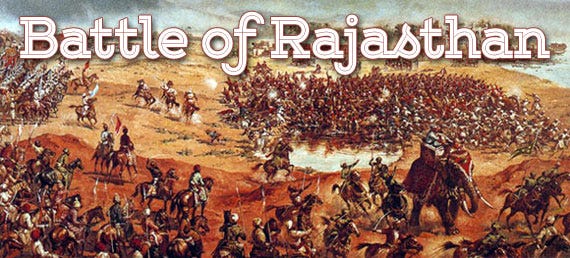
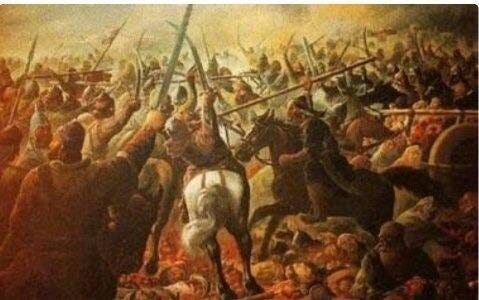


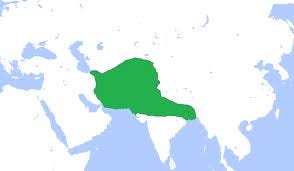

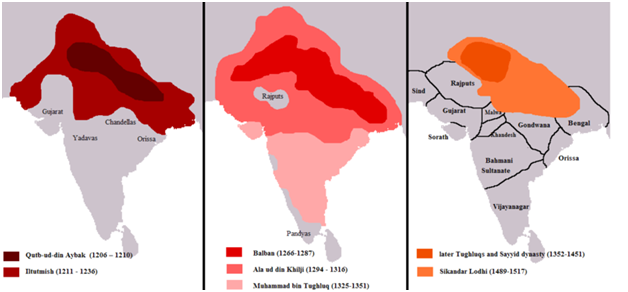

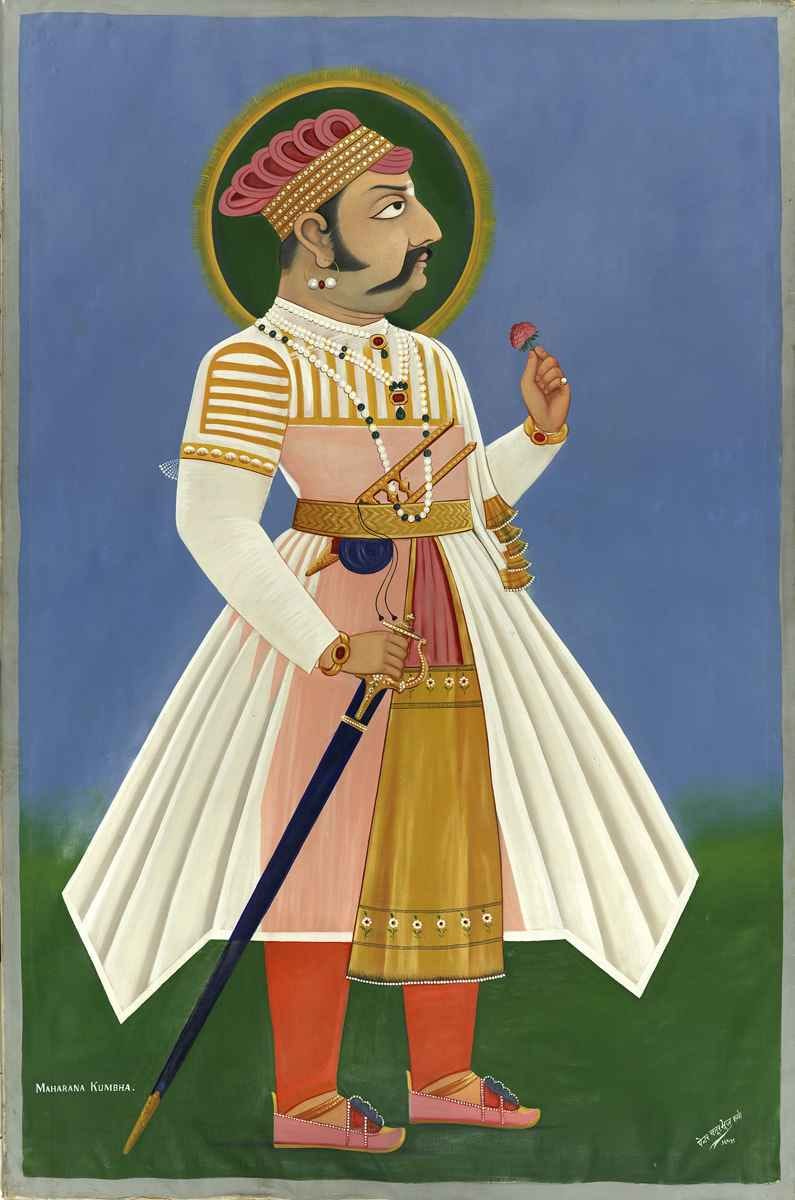
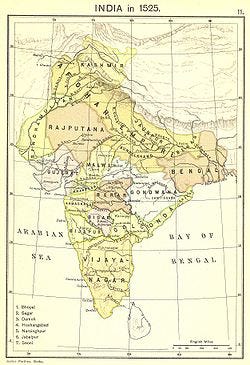
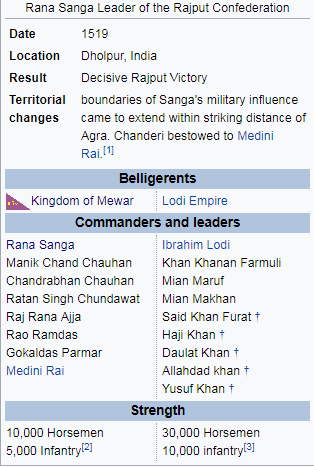


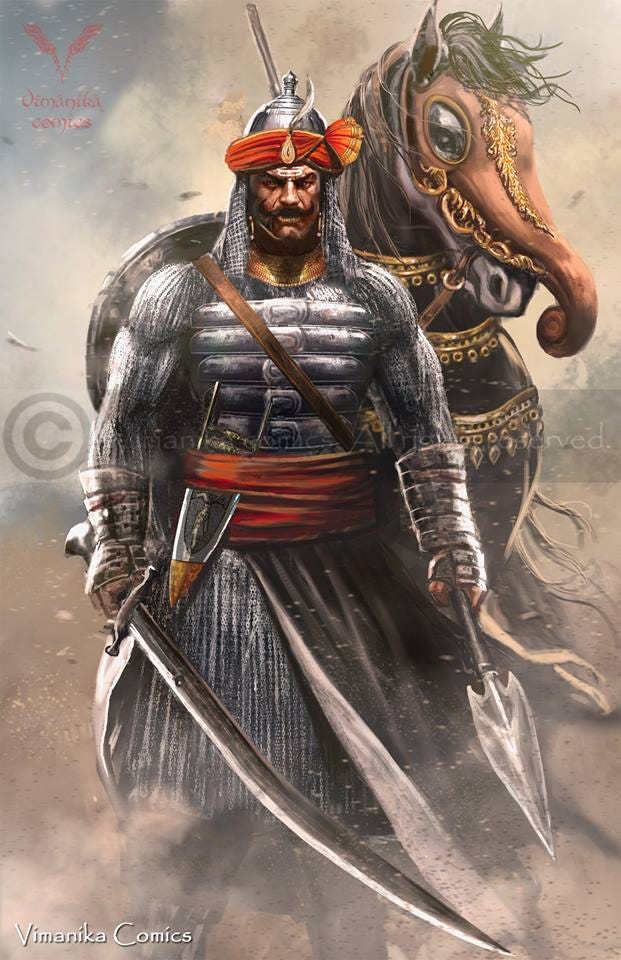
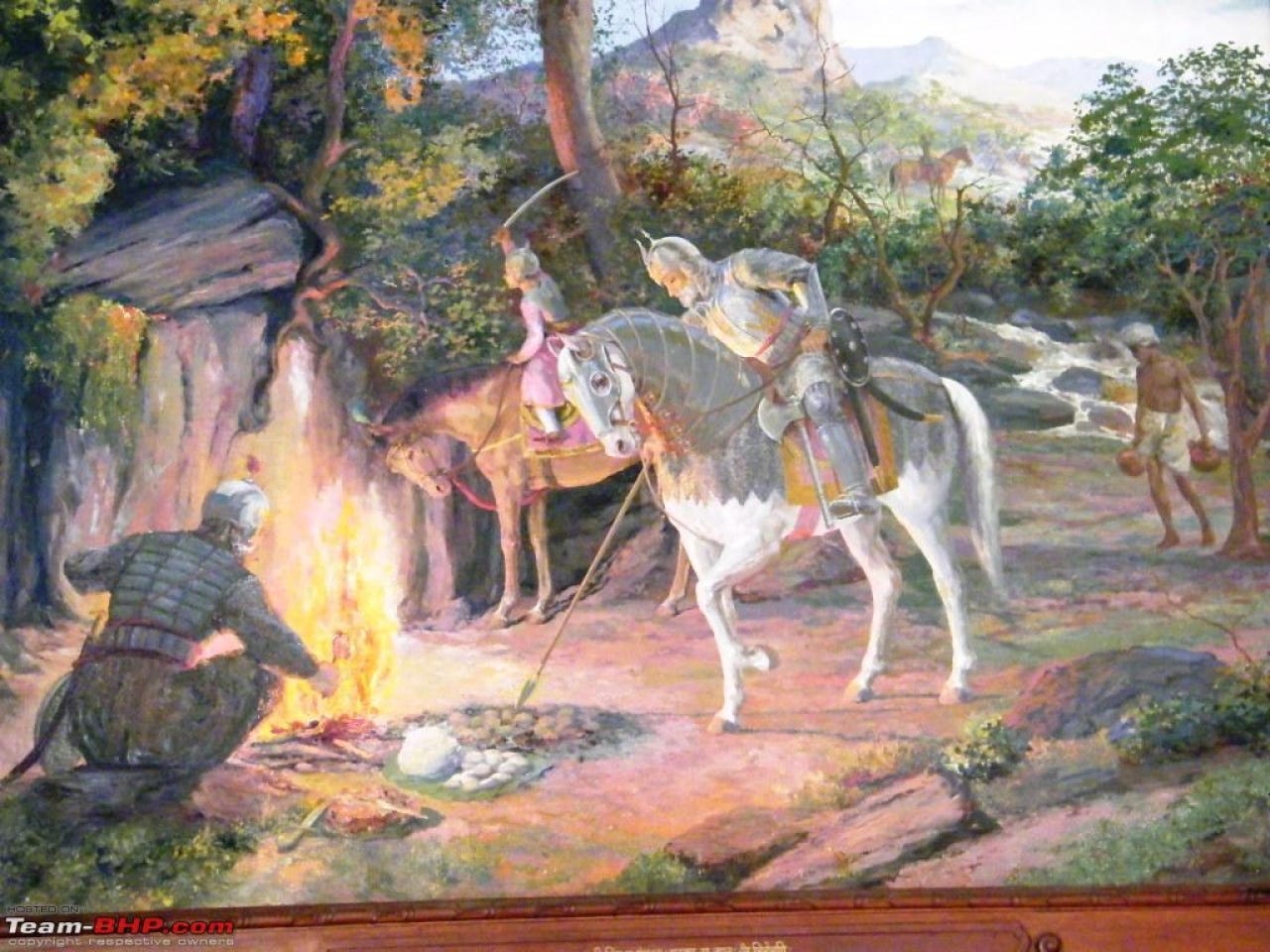








 👊🏻 reply from Maharana shri ji of Mewar to another
👊🏻 reply from Maharana shri ji of Mewar to another 


